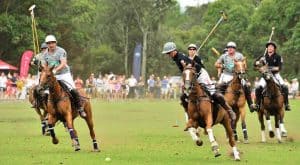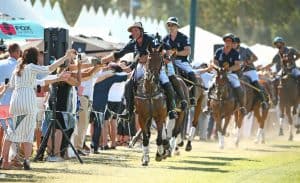Board Alert Interview: Janek Gazecki

A passion for polo led former Sydney lawyer Janek Gazecki to swap the gavel for a mallet to build one of the world’s largest Urban Polo companies.
Urban Polo is now widespread across Australia, with a total of eight events staged annually, under the brand names ‘Polo by the Sea’, ‘Polo in the City’, and new in 2018, ‘Polo in the Vines’.
Director Institute have hosted corporate events at Polo in the City on a number of occasions, and recently spoke with Janek about his experience developing what is now the world’s largest national polo series of any kind.
How did you get involved with Polo?
Being of Polish descent my father believed that every good Pole should know how to ride a horse, so he sent me off to a riding academy at the age of 14.
At that time my association or knowledge of polo was quite limited – I certainly didn’t hail from one of those established polo families which exist here in Australia. But I could ride, and loved horses.
In my late teens / early 20’s I didn’t really have a lot of contact with horse-riding and it was only by chance that a friend introduced me to polo, and immediately I fell in love with it.
What do you love about the game?
There are several things. Firstly, I’m a big nature and animal lover. Spending time with these incredible animals really appealed to me. And as most polo is played in the country, the opportunity to get away from the city for the weekend and play a tournament was something that was really enjoyable.
But most importantly, the sport is addictive and gives you a massive adrenaline rush. The experience of galloping on a 600 – 800 kilogram animal at sixty kilometres an hour while trying to negotiate plays around you, and also hit a ball at that speed is incredible. The sense of focus that stems from that, in addition to the adrenaline is something that I can only describe as a ‘zen’ experience.
It’s a very addictive and challenging sport. I’ve always been an avid sportsman and with every sport you get to a level where you go, oh yeah I get this sport, and I can do it at a reasonable level. But, as a polo player you never really feel that you reach that point because it’s such a challenging sport. There’s so much complexity to the game that you never reach a point where you feel complacent.
How did you turn that love for the sport into ‘Polo in the City’?
At the time I was a lawyer and very quickly started to use polo events out in the country as a vehicle for client entertainment and marketing.
As time went on, I started helping out with local clubs. I began to organise the tournaments, and my involvement organically grew. It reached a point within a few years where it was clear that polo could become the next big thing in terms of client and corporate entertainment as it offered the perfect platform for premium, luxury and performance brands.
It had all the elements that premium brands and many businesses aspire to – dedication, ambition and excellence – all these values can be used to describe the players, the horses and the game itself.

How did you go about bringing Polo to the business community?
In order for polo to become a branding platform for corporate clients, it needed to take place in the city. You couldn’t really entertain clients at scale an hour out of town, which is where the polo fields tend to be anywhere in Australia.
There were a number of things that had to happen to enable the sport to be played in an urban setting. Firstly, we needed to get permission from council to bring the horses into Sydney parks.
Secondly, a traditional polo ball is too dangerous for close proximity, and damning from an insurance perspective. It is as hard, if not harder than a cricket ball, and if a player was to somehow miss-hit the ball, travelling at 200 km per hour, into the crowd – well, you could kill someone.
So, we devised a ball that is approximately five per cent larger than a polo ball and made of a plastic composite. The new ball still flies straight, but is nowhere near as hard or as heavy, so there’s give in it. If it hits you, you might get a bruise, but you won’t get a broken bone.
We also reduced the size of the field. A traditional polo field is 300 metres long, and it’s doesn’t need to be that large. While that size is great for the players because they’re able to run around everywhere, from the spectators’ point of view, once the play is 300 metres away it’s no where near as enjoyable.
So, we literally cut the field in half. Our field is now 140 metres long, and 55 metres wide, which is still three or four soccer fields across – but as a result of this change, the game became a true spectator sport.
As a spectator you can see the action going past you, back and forth, and you can follow the game. As a player, the game becomes quicker. Because you’re on a smaller field, when the ball gets to you, you’ve only got a few moments to get rid of it or make a play.
In the traditional game, a player would get the ball, and with no one close to them for a hundred metres, they’d just stuff around with it, decide what they were going to do with it, then play a shot.
We also changed the rules and removed a lot of the technical fouls. These alterations changed the dynamics of the sport, making the passes quicker, allowing for a faster, free-flowing game.
While the changes were significant – it’s not like this hasn’t happened to most spectator sports over time?
Absolutely. When you look at any successful sport, whether it’s tennis, soccer, or football, all of those sports have, at some point in their history, undergone a major transition to take them from what was once a pastime to a professional sport, which is spectator friendly.
As an example, if you look at soccer, it used to involve a heavy ball, which would move maybe several metres. Now, the balls fly for a 100 metres. You can curl them, lift, drive; you can do all these tricks with them. That was introduced to revolutionise the sport.
When scrutinising polo as a sport – it became apparent the rules of the game hadn’t changed for about two and half thousand years, dating back to when it was first devised. Originally polo wasn’t even devised as a sport, but rather, a training method for the mounted Turkish and Ottoman Calvary.
How long has Urban Polo been running – and have you continued to make changes to the game over the years?
This is our 14th year more or less, while most of the fundamental components of Urban Polo were introduced very early on, we have continued to improve the game as we’ve gone. As an example, we decided that it would be better to make the goals smaller – making it harder to get the goal.
What were some of the biggest challenges you faced when you were building the brand, and event schedule in Australia?
One of the obvious challenges that I thought would materialise was that the polo establishment would push back on the changes I wanted to make. Some Australian families have played the sport for generations.
Certainly there was a lot of political opposition to what I was doing from certain circles, but what actually transpired was that the true establishment, or those people that were ingrained historically in the sport of polo in this country, almost without hesitation, almost without exception, all supported what I was doing.
As an example, the Wayland family took me under their wing at the very beginning and nurtured my polo, not just my playing, but also my aspirations in relation to promoting polo as sport generally. As far as they were concerned, the changes that I was suggesting were all good for polo as a sport.
One of the people that gave me the greatest confidence in facing some of the other criticisms was James Ashton. James regretfully passed away in 2010 following a polo accident when he was seventy years old.
He was an incredible individual. The Ashton family is considered polo royalty in this country.
James Ashton Senior was born in 1860 in Australia to humble circumstances. He had four sons, and they lived on a property in the NSW Southern Tablelands and each holidays the boys would return from school to work on the family property.
Being in such a remote area meant there were not enough men on farms to make up cricket or football teams. Fortunately a retired British Artillery Officer introduced the game of polo to the local township of Goulburn and the four boys took to this new sport with vigour.
From 1920 to 1928 the Ashton brothers devoted much of their time supplying horses to the British Cavalry in India, growing wool and playing polo. They ultimately became the number one polo team in Australia and were unbeatable.
John Ashton was the son of one of those four brothers, and was the President of the Australian Polo Federation for many years.
I remember playing a tournament on his property back in the early days, and he asked me to get into his four wheel drive so he could show me the property – and no doubt quiz me about my plans. I guess he was also looking to see what type of person I was.
He then went on to support me on the board of the APF during his tenure. Most of the opposition I had back then, was actually coming from individuals who wanted to see themselves as members of the polo community – but in actual fact, they were quite new to the game themselves.
Politically, that was something that had to be navigated. Certainly, there were times these people would sabotage events. They would ring up the riders and threaten that they’d never play at any of their tournaments and so on, which is extraordinary, really. But, fortunately, the majority of the community, including the players themselves, have supported this series from the beginning, which has enabled it to become the biggest polo series in the world right now.
That was the political challenge – the other challenge related to the perceived accessibility of the sport. It has been called the sport of kings – which is why some of the nouveau elite were opposing our plans. They liked it being elitist – and inaccessible to every day Australians.
Taking it back to the forbears of the sport in Australia – to James Ashton and his family – the original Australian Polo players were not elitist. The Ashtons were a farming family.
One of the challenges, was to dismantle the elitist image of the sport. The media previously liked to make fun of polo and polo players and it was all hoity-toity, corgis and champagne.
The history of the sport in this country is quite different. The farmers are the custodians. It’s a fun day out. Everyone’s welcome.
While we wanted to dismiss the elitism, we needed to maintain a certain degree of prestige about the sport. To play the sport you’ve got to be dedicated, motivated and you have to seek excellence. These qualities were maintained by Urban Polo, and enabled us to gain support from the Australian public, the media and the sponsors.

What events do you have taking place in 2018?
We have about eight events coming up over the next few months. Each event is held in capital cities or in holiday destinations during the peak season, and is geared to ensure that all spectators have a fabulous day out. There are marquees, bars and clubs.
We’ve got Fashion on the Field happening at each event along with competitions such as sprint races for the public. There are two polo games per event and there is not a dull moment in between because we’ve just got so much stuff going on.
A lot of the activity involves participation from the crowd itself. The crowd
mingle with the players between the games as well, which is a great feature of the event. You don’t get to do that with jockeys at the races.
We are on the cusp of the ‘Land Rover Polo in the City’ season, which is the biggest series within the Urban Polo circuit – commencing on 15th November.
On the 13th of January, we’ve got Polo by the Sea, which is at Palm Beach in New South Wales. And in February, we bring the South of France to Glenelg Beach in Adelaide with ‘Pol Roger Beach Polo’. To see a local city beach converted into a polo festival is incredible.
We’ll also be launching a new event – Polo in the Vines in the Hunter Valley in 2018.
The concept behind Polo in the Vines is to create a more European experience. The event will be held in autumn where spectators can wear warmer, slightly more sophisticated outfits. And the event will feature the incredible red wines from the region.
This event is a far more boutique than say Polo in the City, which can support 3,500 spectators (still small compared with the Races which brings in 15,000 people). Polo in the Vines will be even more intimate with only 700 spectators.
Renowned international chef, and hatted restaurant owner, Guillaume will be hosting and presenting a six-course meal with matching local wines to 80 or so VIP’s as part of this incredible event – and the location is divine. It literally took three years to find the location. I visited every available winery in the Clare Valley, Margaret River and Yarra Valley – before finally finding the Dark Horse Vineyard in the Hunter Valley, which is perfect.
We knew that the location chosen needed to have the field immediately adjacent to the actual vines. The event will be held in autumn – so the colours of the vines will be spectacular. The owners of the vineyard have converted an old barn into a magnificent Hermes style showroom, which will be the location for our VIP enclosure. The space is magnificent.
Are you looking to export Urban Polo overseas?
The answer is yes, and we’re making moves into America. We’ve just recently finalised our trademark registration for Polo in the City, which is our main Urban Polo asset. With that done we can now finally open the door to the US.
For more information on tickets to Urban Polo click here.
